List of United States Supreme Court cases, volume 182
| Supreme Court of the United States | |
|---|---|
 | |
| Established | March 4, 1789[1] |
| Location | Washington, D.C. |
| Coordinates | 38°53′26″N 77°00′16″W / 38.89056°N 77.00444°WCoordinates: 38°53′26″N 77°00′16″W / 38.89056°N 77.00444°W |
| Composition method | Presidential nomination with Senate confirmation |
| Authorized by | Constitution of the United States, Art. III, § 1 |
| Judge term length | life tenure, subject to impeachment and removal |
| Number of positions | 9 (by statute) |
| Website | supremecourt |
| This article is part of the series on the |
| Supreme Court of the United States |
|---|
 |
| The Court |
|
| Current membership |
|
| Lists of justices |
|
| Court functionaries |
|
|
| Constitutional law of the United States |
|---|
 |
| Overview |
|
| Principles |
|
| Government structure |
|
| Individual rights |
|
| Theory |
|
This is a list of the 24 cases reported in volume 182 of United States Reports, decided by the Supreme Court of the United States in 1901.
Justices of the Supreme Court at the time of volume 182 U.S.[]
The Supreme Court is established by Article III, Section 1 of the Constitution of the United States, which says: "The judicial Power of the United States, shall be vested in one supreme Court . . .". The size of the Court is not specified; the Constitution leaves it to Congress to set the number of justices. Under the Judiciary Act of 1789 Congress originally fixed the number of justices at six (one chief justice and five associate justices).[2] Since 1789 Congress has varied the size of the Court from six to seven, nine, ten, and back to nine justices (always including one chief justice).
When the cases in volume 182 were decided the Court comprised the following nine members:
| Portrait | Justice | Office | Home State | Succeeded | Date confirmed by the Senate (Vote) |
Tenure on Supreme Court |
|---|---|---|---|---|---|---|
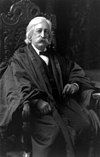
|
Melville Fuller | Chief Justice | Illinois | Morrison Waite | July 20, 1888 (41–20) |
October 8, 1888 – July 4, 1910 (Died) |
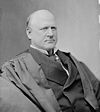
|
John Marshall Harlan | Associate Justice | Kentucky | David Davis | November 29, 1877 (Acclamation) |
December 10, 1877 – October 14, 1911 (Died) |
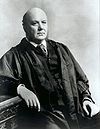
|
Horace Gray | Associate Justice | Massachusetts | Nathan Clifford | December 20, 1881 (51–5) |
January 9, 1882 – September 15, 1902 (Died) |
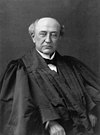
|
David Josiah Brewer | Associate Justice | Kansas | Stanley Matthews | December 18, 1889 (53–11) |
January 6, 1890 – March 28, 1910 (Died) |

|
Henry Billings Brown | Associate Justice | Michigan | Samuel Freeman Miller | December 29, 1890 (Acclamation) |
January 5, 1891 – May 28, 1906 (Retired) |
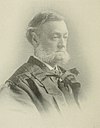
|
George Shiras Jr. | Associate Justice | Pennsylvania | Joseph P. Bradley | July 26, 1892 (Acclamation) |
October 10, 1892 – February 23, 1903 (Retired) |

|
Edward Douglass White | Associate Justice | Louisiana | Samuel Blatchford | February 19, 1894 (Acclamation) |
March 12, 1894 – December 18, 1910 (Continued as chief justice) |
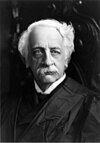
|
Rufus W. Peckham | Associate Justice | New York | Howell Edmunds Jackson | December 9, 1895 (Acclamation) |
January 6, 1896 – October 24, 1909 (Died) |
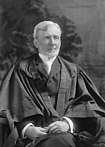
|
Joseph McKenna | Associate Justice | California | Stephen Johnson Field | January 21, 1898 (Acclamation) |
January 26, 1898 – January 5, 1925 (Retired) |
Notable Cases in 182 U.S.[]

Insular Cases[]
The Insular Cases are a series of opinions by the Supreme Court in 1901 (the first six opinions in 182 U.S., at pages 1-397, all authored by Justice Henry Billings Brown, along with various concurring and dissenting opinions by other Justices), about the status of U.S. territories acquired in the Spanish–American War, such as the Philippines.[3] The Supreme Court held in the Insular Cases that full constitutional protection of rights does not automatically extend to all places under American control. This meant that inhabitants of unincorporated territories such as Puerto Rico—"even if they are U.S. citizens"—may lack some constitutional rights (e.g., the right to remain part of the United States in case of de-annexation)[4] because they were not part of the United States.
Citation style[]
Under the Judiciary Act of 1789 the federal court structure at the time comprised District Courts, which had general trial jurisdiction; Circuit Courts, which had mixed trial and appellate (from the US District Courts) jurisdiction; and the United States Supreme Court, which had appellate jurisdiction over the federal District and Circuit courts—and for certain issues over state courts. The Supreme Court also had limited original jurisdiction (i.e., in which cases could be filed directly with the Supreme Court without first having been heard by a lower federal or state court). There were one or more federal District Courts and/or Circuit Courts in each state, territory, or other geographical region.
The Judiciary Act of 1891 created the United States Courts of Appeals and reassigned the jurisdiction of most routine appeals from the district and circuit courts to these appellate courts. The Act created nine new courts that were originally known as the "United States Circuit Courts of Appeals." The new courts had jurisdiction over most appeals of lower court decisions. The Supreme Court could review either legal issues that a court of appeals certified or decisions of court of appeals by writ of certiorari.
Bluebook citation style is used for case names, citations, and jurisdictions.
- "# Cir." = United States Court of Appeals
- e.g., "3d Cir." = United States Court of Appeals for the Third Circuit
- "C.C.D." = United States Circuit Court for the District of . . .
- e.g.,"C.C.D.N.J." = United States Circuit Court for the District of New Jersey
- "D." = United States District Court for the District of . . .
- e.g.,"D. Mass." = United States District Court for the District of Massachusetts
- "E." = Eastern; "M." = Middle; "N." = Northern; "S." = Southern; "W." = Western
- e.g.,"C.C.S.D.N.Y." = United States Circuit Court for the Southern District of New York
- e.g.,"M.D. Ala." = United States District Court for the Middle District of Alabama
- "Ct. Cl." = United States Court of Claims
- "Ct. Com. Pl." = Court of Common Pleas (a state court)
- The abbreviation of a state's name alone indicates the highest appellate court in that state's judiciary at the time.
- e.g.,"Pa." = Supreme Court of Pennsylvania
- e.g.,"Me." = Supreme Judicial Court of Maine
List of cases in volume 182 U.S.[]
| Case Name | Page & year | Opinion of the Court | Concurring opinion(s) | Dissenting opinion(s) | Lower Court | Disposition of case |
|---|---|---|---|---|---|---|
| DeLima v. Bidwell (an Insular Case) | 1 (1901) | Brown | none | McKenna, Gray | C.C.S.D.N.Y. | reversed |
| Goetze v. United States (an Insular Case) | 221 (1901) | Brown | none | none | C.C.S.D.N.Y. | reversed |
| Dooley v. United States (an Insular Case) | 222 (1901) | Brown | none | White | C.C.S.D.N.Y. | reversed |
| Armstrong v. United States (an Insular Case) | 243 (1901) | Brown | none | none | Ct. Cl. | reversed |
| Downes v. Bidwell (an Insular Case) | 244 (1901) | Brown | White, Gray | Fuller, Harlan | C.C.S.D.N.Y. | affirmed via plurality |
| Huus v. New York & P.R.S.S. Co. (an Insular Case) | 392 (1901) | Brown | none | none | 2d Cir. | remanded to divided lower court |
| Carson v. Brockton Sewerage Comm'n | 398 (1901) | Brown | none | none | Mass. | affirmed |
| Ramsdell Transp. v. Compagnie Gen. Transatlantique | 406 (1901) | Gray | none | none | 2d Cir. | remanded to divided lower court |
| Lake St. Elevated R.R. Co. v. Farmers' Loan & Tr. Co. | 417 (1901) | Shiras | none | none | Ill. | dismissed for want of jurisdiction |
| Reagan v. United States | 419 (1901) | Fuller | none | none | Ct. Cl. | affirmed |
| Simon v. Craft | 427 (1901) | White | none | none | Ala. | affirmed |
| Pirie v. Chicago Title Tr. Co. | 438 (1901) | McKenna | none | Fuller | 7th Cir. | affirmed |
| United States ex rel. Queen v. Alvey | 456 (1901) | McKenna | none | none | D.C. Cir. | rule discharged |
| Clews v. Jamieson | 461 (1901) | Peckham | none | Harlan | 7th Cir. | reversed |
| Calhoun Gold Mining Co. v. Ajax Gold Mining Co. | 499 (1901) | McKenna | none | none | Colo. | affirmed |
| District of Columbia v. Talty | 510 (1901) | McKenna | none | none | Ct. Cl. | affirmed |
| Russell v. United States | 516 (1901) | McKenna | none | none | Ct. Cl. | affirmed |
| Lantry v. Wallace | 536 (1901) | Harlan | none | none | 8th Cir. | affirmed |
| Hood v. Wallace | 555 (1901) | Harlan | none | none | 8th Cir. | affirmed |
| Commerce Nat'l Bank v. Chambers | 556 (1901) | White | none | none | Utah | affirmed |
| Fuller v. United States | 562 (1901) | Harlan | none | none | Ct. App. Indian Terr. | rule discharged |
| District of Columbia v. Moulton | 576 (1901) | White | none | none | D.C. Cir. | reversed |
| Jacobs v. Marks | 583 (1901) | Shiras | none | none | Ill. | affirmed |
| Glavey v. United States | 595 (1901) | Harlan | none | none | Ct. Cl. | reversed |
Notes and references[]
- ^ Lawson, Gary; Seidman, Guy (2001). "When Did the Constitution Become Law?". Notre Dame Law Review. 77: 1–37.
- ^ "Supreme Court Research Guide". Georgetown Law Library. Retrieved April 7, 2021.
- ^ Lin, Tom C.W., Americans, Almost and Forgotten, 107 California Law Review (2019)
- ^ Levinson, Sanford & Sparrow, Bartholomew H. (2005). "Introduction". In Levinson, Sanford & Sparrow, Bartholomew H. (eds.). The Louisiana Purchase and American Expansion: 1803–1898. Lanham, MD: Rowman and Littlefield Publishers. p. 15. ISBN 9780742549838. OCLC 58976044.
See also[]
- Certificate of division
External links[]
- [1] Case reports in volume 182 from Library of Congress
- [2] Case reports in volume 182 from Court Listener
- [3] Case reports in volume 182 from the Caselaw Access Project of Harvard Law School
- [4] Case reports in volume 182 from Google Scholar
- [5] Case reports in volume 182 from Justia
- [6] Case reports in volume 182 from Open Jurist
- Website of the United States Supreme Court
- United States Courts website about the Supreme Court
- National Archives, Records of the Supreme Court of the United States
- American Bar Association, How Does the Supreme Court Work?
- The Supreme Court Historical Society
- Lists of United States Supreme Court cases by volume
- 1901 in United States case law

